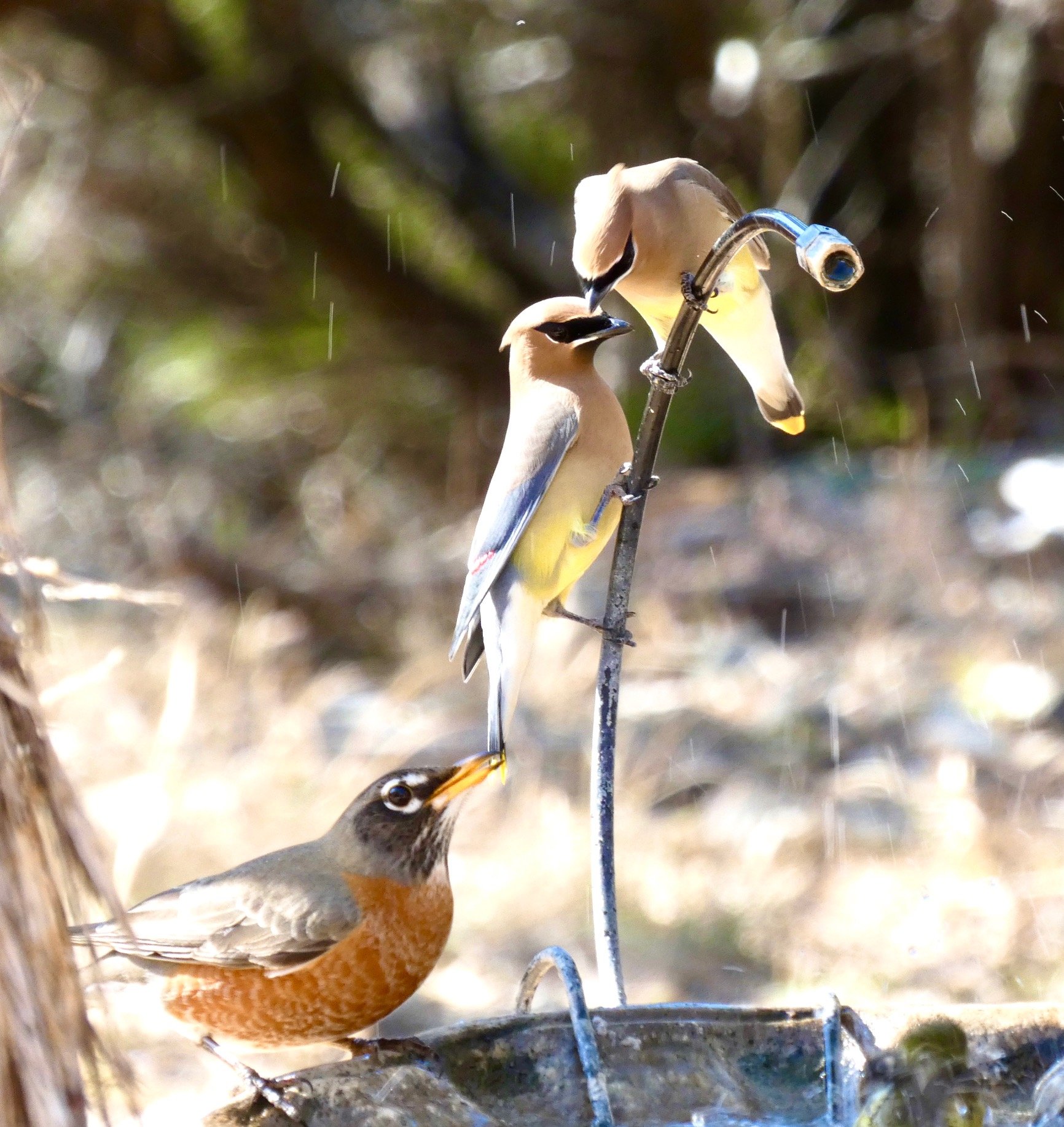NatureWatch
HCMN Photo Journal
Spring 2024
A Summer Tanager and a Painted Bunting at the water drip. Photo: courtesy Pat Heintz
More of Pat’s story and pictures round out this HCMN photo journal piece. Don’t miss them below!
Hays County Master Naturalists
Anything with Wings!
Tom Hausler
At Westcave Preserve we’ve been doing a dragonfly survey for the last several years, but due to the lack of rain this year, there have been few dragonflies. So we changed our focus to butterflies—code name “Anything with Wings.” Here are a few of the winged beings we have documented over recent months.
Huron Sachem (a small grass skipper butterfly) on Texas thistle Photo: courtesy Tom Hausler
Red Admiral Photo: courtesy Tom Hausler
Orange Sulphur Butterflies mating Photo: courtesy Tom Hausler
Checkered Skipper on Indian Blanket wildflower Photo: courtesy Tom Hausler
Gulf Fritillary on Texas thistle Photo: courtesy Tom Hausler
Black Swallowtail on Texas thistle Photo: courtesy Tom Hausler
Common Buckeye Photo: courtesy Tom Hausler
Queen Butterflies on Texas thistle Photo: courtesy Tom Hausler
And this gorgeous guy is a Maroon-legged Lion Fly, a member of the robber fly family Asilidae Photo: courtesy Tom Hausler
A Mystery Solved
Betsy Cross
Common sunflowers—the same ones you see in the ditches and fields along Texas roadways—grow wild in my backyard. Some people may consider this wildflower a nuisance or even a weed, but I’ve found it to be a natural bird feeder and attractor. Lesser goldfinches love the seeds, hummers buzz around the flowers, nectaring all summer long, and lots of other birds—blue-gray gnatcatchers, yellow warblers, and summer tanagers—feed on the insects that hang out on this plant.
Recently, I noticed that my little grove of sunflowers was being decimated. Leaves were totally shredded, but there was no sign of the guilty party. A few days later and a closer look revealed the culprit. Wow, how did I miss these guys—caterpillars everywhere! I took a few pictures for reference, and then I spotted another clue: a beautiful, fresh, orange and black butterfly. Photo: courtesy Betsy Cross
I’ve seen these butterflies in my yard over the years, but who knew. Turns out that the sunflower is a host plant for the Bordered Patch Butterfly, and it’s common for our Common Sunflower to feed hundreds of these caterpillars at one time, which was an accurate description of the situation. Photo: courtesy Betsy Cross
Bordered Patch Butterfly with wings folded
Photo: courtesy Betsy Cross
Bordered Patch caterpillars in various instar stages
Photo: courtesy Betsy Cross
Here’s a website with photos and captions that perfectly describe what happened in my backyard: http://www.raisingbutterflies.org/bordered-patch/. And by the way, June 17-23 was National Pollinator Week.
Bird Sanctuary - The “Lazy Birders”
Pat Heintz
Our backyard bird sanctuary has evolved into its current state as we have learned through trial and error what seems to work best. Since creating this space, we have logged close to 50 different bird species in our backyard bird haven.
On the bird feeder poles, we offer a variety of seeds, nuts, and dried fruits, as well as white millet for the Painted Buntings. We have also drilled holes in some of the stumps, which we fill with a hot pepper “bark butter.” The birds don’t mind the heat, and the hot mix deters the squirrels and raccoons.
Of most importance is the water drip. While some birds will come to feeders, all birds are attracted to water. We provide a very slow, intermittent drip (approximately a drip every 3-4 seconds). It is said that some birds can hear the “plop” up to a half-mile away. If your drip is active 10 hours each day, it requires less than one gallon of water per day, though this estimation can depend on the variables.
The sanctuary is enclosed with what we refer to as “cedar bones”—the preserved remains of dead Ashe juniper trees from our land. This wood has natural oils and acids, which protect it from moisture and decay. It also contains phenols, which repel insects and termites. Because of these natural protections, the aged Ashe juniper makes excellent enclosure material and provides some sense of seclusion and protection for the birds. Photo: courtesy Pat Heintz
Painted Bunting Photo: courtesy Pat Heintz
Scrub Jay Photo: courtesy Pat Heintz
Cedar Waxwings taking turns, with a Robin waiting in line. Photo: courtesy Pat Heintz
Here’s another view of the sanctuary with the water drip and hanging hummingbird feeder. Photo courtesy Pat Heintz
Water feature with slow drip
Photo courtesy Pat Heintz
Cedar stump with bark butter-filled holes
Photo: courtesy Pat Heintz
Slatted patio walls for bird watching and photographing Photo: courtesy Pat Heintz
We can view our bird sanctuary from either our outside slatted patio cover or from the comfort of our sun room wing back chairs (thus the “lazy birder” tag). Photo: courtesy Pat Heintz






















